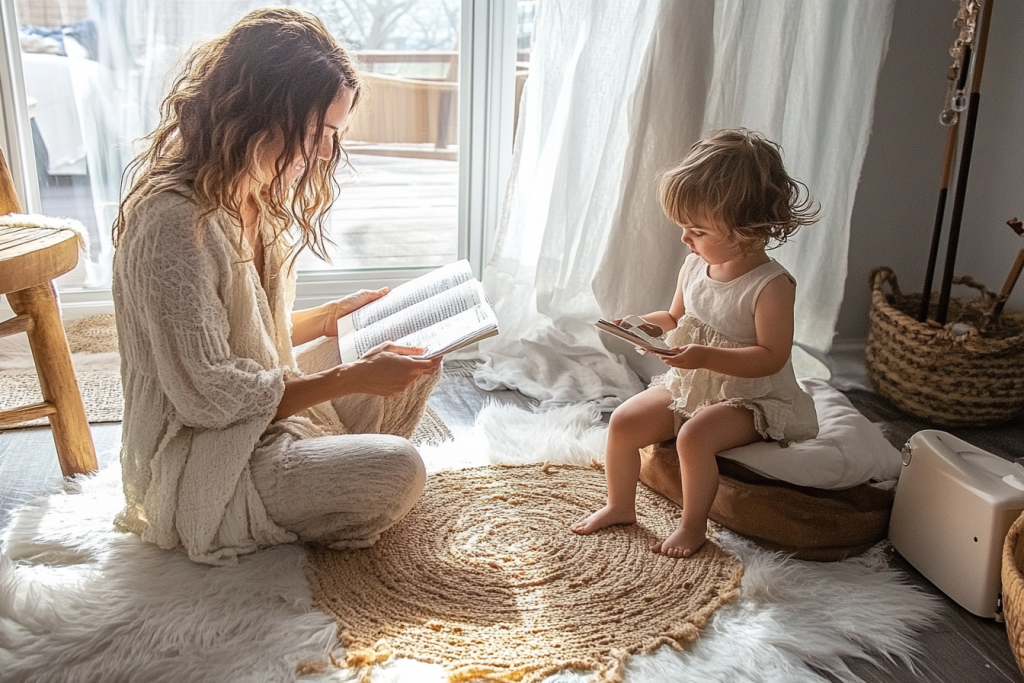Peaceful parenting begins with small, intentional habits that shape your daily connection with your child. It’s not about being perfect—it’s about being present, consistent, and compassionate. These simple habits reduce power struggles, build trust, and create emotional safety in the parent-child relationship.
Start the Day With Connection
Greet With Eye Contact and Warmth
A calm “Good morning” with a hug sets the emotional tone. Your child learns that their presence matters before tasks or corrections begin.
Keep Mornings Unhurried
Build in buffer time to avoid rushing. A few extra minutes create space for cooperation and reduce your anxiety.
Use Calm Language Consistently
Speak at Eye Level
When giving instructions or feedback, kneel or sit at your child’s level. This posture invites connection and reduces defiance.
Choose Words That Guide, Not Shame
Say, “Let’s try it this way,” instead of “Why can’t you get it right?” Replace criticism with encouragement to build confidence and trust.

Stay Consistent With Boundaries
Follow Through With Gentle Authority
Children feel safe when expectations are clear. If bedtime is at 8, stick to it kindly but firmly.
Explain the “Why” Behind the Rule
Say, “We leave the park now so we have time for dinner and rest,” helping your child feel respected rather than controlled.
Practice Daily One-on-One Time
Even 10 Minutes Makes a Difference
Schedule short, focused time each day without phones or chores. Play, read, talk—just be fully present.
Let Your Child Lead the Activity
Letting your child choose builds autonomy and emotional connection. Follow their joy and curiosity without directing.

Validate Emotions Without Judgment
Say What You See
Use phrases like “You’re upset right now” to show your child they’re heard and understood, even if the behavior isn’t acceptable.
Offer Comfort Before Correction
Children calm down faster when they feel safe. Once emotions settle, revisit behavior with kindness and clarity.
Model Calm Under Pressure
Breathe Before You React
A 3-second pause can prevent yelling. This simple reset teaches emotional regulation by example.
Narrate Your Calm Choices
Say, “I’m feeling frustrated, so I’m taking a breath before I speak.” Kids learn by watching how you handle stress.
Use Positive Discipline Strategies
Focus on Teaching, Not Punishing
Guide your child toward better choices with explanations, not threats. “Hands are for helping” is more effective than “Don’t hit.”
Let Natural Consequences Teach
If a toy is misused, it temporarily disappears. The consequence makes sense, feels fair, and invites cooperation.
Build Emotional Rituals Into Daily Life
End Each Day With Reconnection
Bedtime is perfect for asking, “What was your favorite part of today?” Reconnect and reinforce love before sleep.
Use Simple Affirmations
Say, “You are safe,” “You are loved,” and “We can handle anything together.” These words ground your child emotionally and reduce anxiety.

Keep Screens From Interrupting Bonding
Protect Key Times
No screens during meals, playtime, or bedtime. These windows of connection matter more than constant availability.
Be Fully Present
Put your phone away. Just five minutes of real presence often exceeds an hour of distracted time.
Repair After Rough Moments
Apologize and Reconnect
If you yell or lose patience, acknowledge it. “I was overwhelmed and raised my voice. You didn’t deserve that.” This will model humility and build trust.
Invite Your Child to Express Themselves
Ask, “How did that feel to you?” Let them share their side of a disagreement. It strengthens mutual respect and healing.
Embrace Simplicity Over Perfection
Let Go of Control
You don’t need to manage every outcome. Trust your child’s capacity to learn, adapt, and grow.
Celebrate Small Wins
Did your child manage a tantrum better? Did you stay calm through a challenge? These small moments are considerable progress.
Conclusion
Peaceful parenting isn’t about avoiding all conflict. It’s about responding with presence, consistency, and empathy. These simple habits—daily rituals, calm communication, and emotional support—build a loving environment where your child feels safe, respected, and connected. When practiced consistently, peaceful parenting becomes a way of life that transforms both you and your child.

